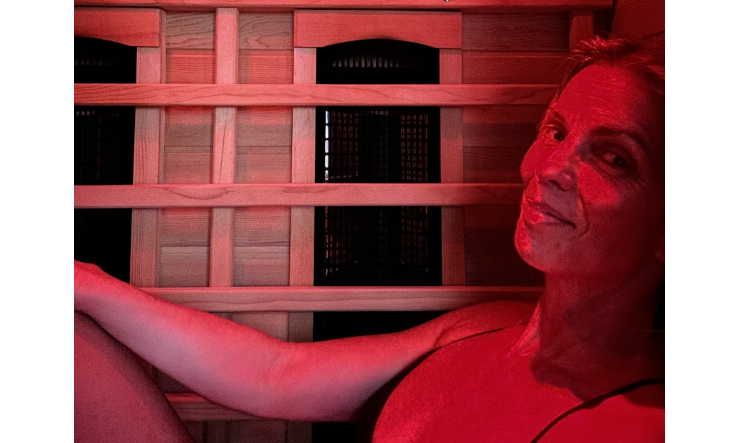Infrared rays generate heat; they directly heat the body rather than the surrounding air. When it comes to skin care, here's how an infrared sauna could help improve your skin health and complexion:
- Improved blood circulation : The heat generated by infrared saunas can help stimulate blood circulation. 1 Improved blood circulation means more oxygen and nutrients are transported to the skin, which can help improve its appearance and radiance.
- Pore Cleansing : Sauna-induced sweating can help open pores 2,3 and expel impurities and dead skin cells, contributing to a clearer, healthier complexion.
- Hydration : Excessive sweating can actually help flush toxins out of the skin. After a sauna, it is essential to rehydrate, which can also help keep the skin hydrated. 4
- Stimulation of collagen production : Some studies suggest that the heat from infrared saunas can stimulate the production of collagen, a protein that helps keep skin firm and elastic. 5
- Relaxation and stress reduction : Using an infrared sauna can be a relaxing experience and help improve mood 6 , which can have positive effects on the skin. Stress has been linked to various skin problems, so any activity 7 that helps reduce stress can also help improve skin health.
How to Use a Sauna According to Dr. Josh Axe
Here are some points to keep in mind when using an infrared sauna:
Preparation for the session
- Hydration : Drink water before your session to stay hydrated. It is important to be well hydrated before entering the sauna.
- Clothing : You should wear comfortable clothing, such as a swimsuit or lightweight, moisture-wicking clothing.
-
Heat up the sauna
Turn on the infrared sauna and let it warm up. Specific instructions may vary depending on the sauna model, so follow the manufacturer's guidelines. -
Set the temperature
Infrared saunas typically have adjustable temperature settings. Start with a lower temperature (around 100–130°F or 37–54°C) if you're new to infrared saunas, and gradually increase it to your comfort level. -
Set the timer
Most infrared saunas have a timer function. Start with a shorter session, such as 15 to 20 minutes, and increase the duration as you get used to the heat. -
Enter the sauna
Once the sauna has reached the desired temperature, enter and close the door. Sit or lie down on a towel or bench. -
Relax and enjoy
Relax and let the infrared heat penetrate your body. You may want to bring a towel or small napkin to wipe away sweat. -
Hydration
Bring a water bottle with you to stay hydrated. Sip water as needed during your session.
Breathe deeply:
Breathe deeply and focus on relaxing. You can meditate, read, or listen to soothing music if you wish. -
Get out safely
Once your session is over or if you begin to feel uncomfortable, exit the sauna. Allow your body to cool down gradually by sitting or lying down. -
Return to calm
After leaving the sauna, take a cool shower or use a damp towel to wipe off sweat. This can help regulate your body temperature and cool you down. -
Rest and hydrate
Give your body time to cool down and rest. Continue to hydrate by drinking water to replace fluids lost through sweat.
References:
1. Vuori I. Sauna bather's circulation. Ann Clin Res. 1988;20(4):249-56. PMID: 3218896.
3. Doctissimo
4. Kowatzki D, Macholdt C, Krull K, Schmidt D, Deufel T, Elsner P, Fluhr JW. Effect of regular sauna on epidermal barrier function and stratum corneum water-holding capacity in vivo in humans: a controlled study. Dermatology. 2008;217(2):173-80. doi:10.1159/000137283. Epub 2008 Jun 5. PMID: 18525205.
5. Lee JH, Roh MR, Lee KH. Effects of infrared radiation on skin photo-aging and pigmentation. Yonsei Med J. 2006 Aug 31;47(4):485-90. doi: 10.3349/ymj.2006.47.4.485. PMID: 16941737; PMCID: PMC2687728.
6. Masuda A, Koga Y, Hattanmaru M, Minagoe S, Tei C. The effects of repeated thermal therapy for patients with chronic pain. Psychother Psychosom. 2005;74(5):288-94. doi:10.1159/000086319. PMID: 16088266.
7. Huhtaniemi IT, Laukkanen JA Endocrine effects of sauna bath. Opinion. Endocr. Metab. Res. 2020;11:15–20. doi: 10.1016/j.coemr.2019.12.004. https://www.sciencedirect.com/science/article/abs/pii/S2451965019301048?via%3Dihub




































































comment
Bonjour,
Je suis très intéressée à l’idée de me procurer un sauna infra-rouge. Pouvez-vous me conseiller à savoir où il serait bien d’en acheter un svp
Chantale merci!
Leave a comment